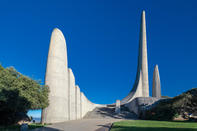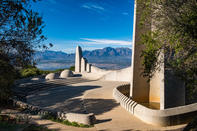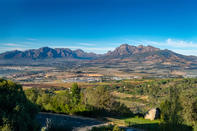
Paarl. Be sure to take the time to appreciate the symbolism in the various components. The associated museum is in Pastorie Street.
Symbolism Explained

The Taal Monument (language monument) was designed by Jan van Wijk, and is built of concrete, standing amongst granite boulders and indigenous trees overlooking Paarl.
The monument has some distinctive features: the three linked columns represent the contribution of the West, three round shapes represent the magic, mystery and traditions of Africa, a low wall depicts the cultural contribution of the Indonesian people to Afrikaans, and a rising wall merges into a covered corridor symbolising a bridge, representing the way Afrikaans forms a link between Africa and Europe.
The corridor leads to a 57 m high pillar, which rises from a spring of clear water. The pillar, which is hollow, has light emanating from the top, illuminating the water below. Another pillar, parallel and close to the language pillar, symbolises political growth of the Republic of South Africa.
Establishing a Language

Culturally, Paarl played a major role in the establishment of the Afrikaans language. In the 1870’s, a teacher of classical languages at the Paarl Gymnasium, Arnoldus Pannevis, observed that although Dutch was the established language, the majority of the people actually had very little understanding of it.
Over the years, many of the common people no longer used High Dutch to communicate with each other, to such an extent that it could no longer be deemed a dialect, but was, in fact, a new language, Afrikaans had evolved. Pannevis and his colleagues discussed this matter many times and at a meeting at the homestead of Gideon Malherbe (a farmer who had married the daughter of the Principal of the Gymnasium), and in 1875, the Genootskap van Regte Afrikaners (Institute of True Afrikaners) was formed.
Its purpose was to ensure that Afrikaans became established as a written and an accepted language. Pannevis and his colleagues worked on the grammar and vocabulary of this new language. In 1876, they launched the first ever Afrikaans newspaper, Die Afrikaanse Patriot, printed on a press at Malherbe's house. Later, this little press also produced many books in Afrikaans.
The first congress on language was held in Paarl in 1896 and after a successful campaign, Afrikaans became an official language of South Africa. Gideon Malherbe’s home is beautifully restored and is now the Afrikaans Language Museum.